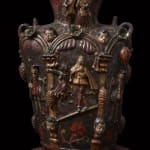Tibor Depicting a Gallant Court Scene, 17th century
Earthenware
Molded, shaped, painted with slip (engobe) and burnished; single firing
Further images
A Tibor is a ceramic jar originally from Asia, with a decorative function or used as a recipient to store or transport vanilla, chocolate and spices. This type of jar was successfully introduced to New Spain as a result of the trade routes established by the Manila Galleon, which is why the ceramics produced in Tonalá and the Talavera pottery of Puebla include this form in their repertoires. The Tibors of Tonalá often include a lid and were exhibited as prized possessions on painted or gilded wooden bases. As luxury objects, their sole purpose was to contain water and provide the aromas that had made them famous. Letters from the Florentine scholar and scientist Lorenzo Magalotti (1637- 1712) refer to the presence of Tibors in various collections including the Royal Palace of Turin, the Quirinal Palace in Rome and in the collection of Cosimo III in Florence, as well as the major collection of the Count of Oñate in Spain. It is very interesting to note that of all the Tibors known to exist in the collections of the Museum of the Americas in Madrid, the Herzog Anton Ulrich Museum, and the Ethnological Museum of Barcelona, this is the only example known to show so many relief figures engaged in elegant courtly scenes. Its rarity and artistic uniqueness therefore make it one of the finest examples of its kind.
The collection of the Museum of the Americas holds an example with the same type of composition: the triple arcade on the front and some relief elements including a fashionably-attired figure, pomegranates and cherubs, but it does not show as many figures or the gallant scene of our elegant Tibor.
read Essay







